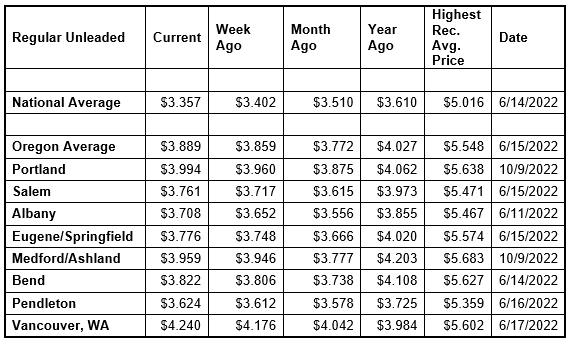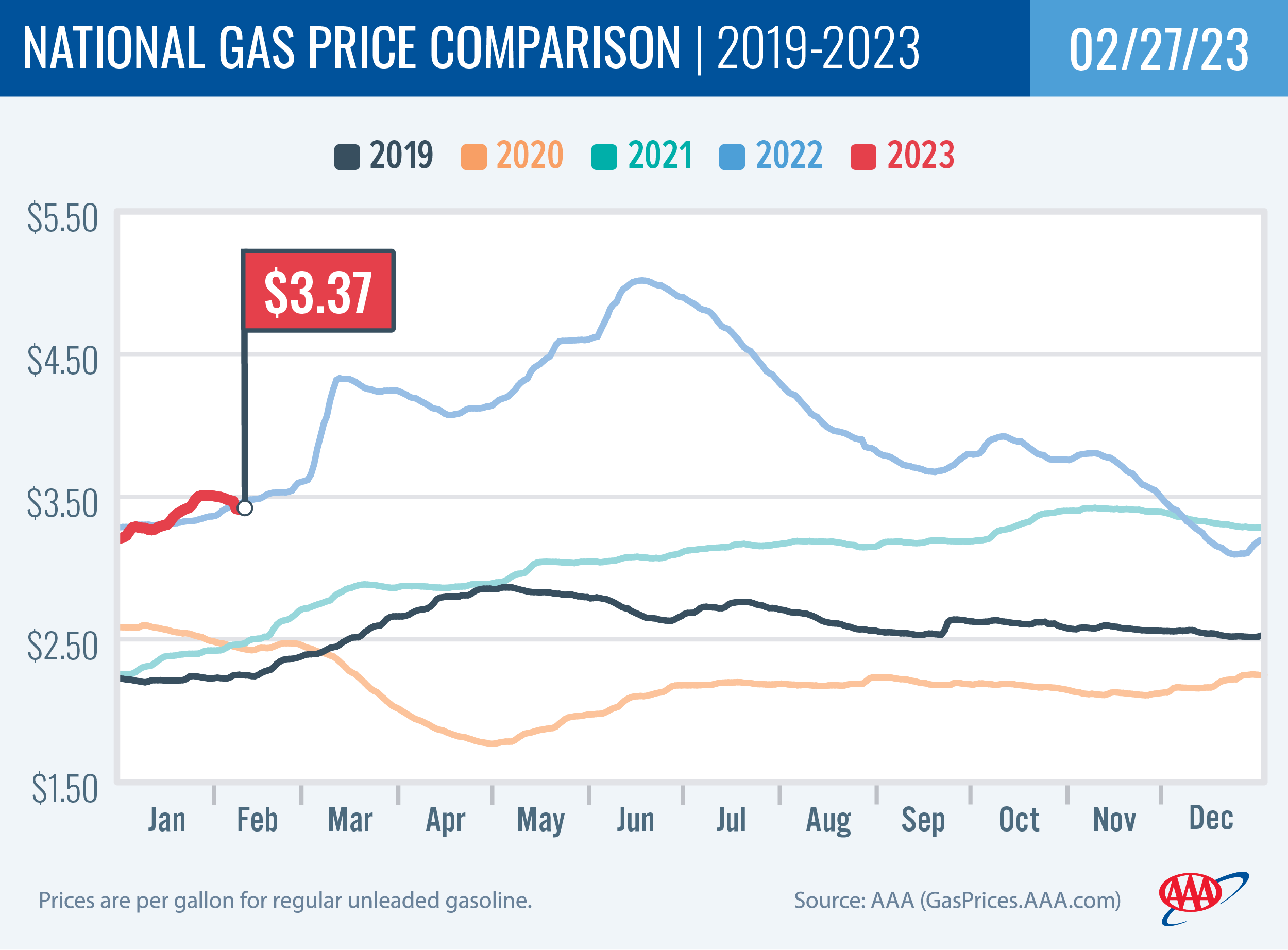West Coast Prices Continue to Edge Up, due in part to Switch to Summer-blend Gas
Updated 2/28/2023
PORTLAND, Ore., – While most states are seeing small to moderate declines this week, Oregon and other West Coast states as well as some states in the Great Lakes area are seeing pump prices climb. The increases on the West Coast are mostly due to the start of the annual switch to summer-blend gas. For the week, the national average for regular unleaded slips four cents to $3.36. The Oregon average adds three cents to $3.89.

“Many refineries on the West Coast, especially in California, have already started the switch to summer-blend fuel ahead of California’s April 1 deadline, pushing pump prices upward,” says Marie Dodds, public affairs director for AAA Oregon/Idaho. “The switch along with refinery maintenance are the main drivers of the seasonal run-up in pump prices.”
More info on summer- and winter-blend gasoline can be found at the EPA website.
Crude oil is trading around $77 today compared to $76 a week ago. In January, West Texas Intermediate ranged between about $73 and $82 bbl. and was $92 a year ago. Crude reached recent highs of $123.70 on March 8, 2022, and $122.11 per barrel on June 8, 2022. The all-time high for WTI crude oil is $147.27 in July 2008.
Crude prices tend to increase in response to positive economic news, as growing, thriving economies tend to consume more oil. Crude prices also climb when geo-political events have the potential to disrupt supply. Crude prices rose dramatically leading up to and in the first few months of Russia’s invasion of Ukraine. Russia is one of the world’s top oil producers and its involvement in a war causes market volatility, and sanctions imposed on Russia by the U.S. and other western nations resulted in tighter global oil supplies. Oil supplies were already tight around the world as demand for oil increased as pandemic restrictions eased.
Crude oil is the main ingredient in gasoline and diesel, so pump prices are impacted by crude prices on the global markets. On average, about 56% of what we pay for in a gallon of gasoline is for the price of crude oil, 20% is refining, 11% distribution and marketing, and 14% are taxes, according to the U.S. Energy Information Administration.
Demand for gasoline in the U.S. rose slightly from 8.27 million b/d to 8.91 million b/d for the week ending February 17. This compares to 8.66 million b/d a year ago. Meanwhile, total domestic gasoline stocks decreased by 1.8 million bbl to 240.1 million bbl last week. However, fluctuating oil prices have contributed to pushing the national average and pump prices in many states lower. But if gas demand keeps rising amid tightening domestic stocks, drivers may see an end to future pump price drops.
Quick stats
Oregon is one of only seven states with a week-over-week increase. All of these states are in the West Coast and Great Lakes regions. Alaska (+5 cents) and California (+4 cents) have the largest increases. Delaware (-11 cents) and Ohio (-11 cents) have the largest weekly declines.
Hawaii ($4.88) is the state with the most expensive gas in the nation for the 14th week in a row. California ($4.77) is second, Nevada ($4.25) is third, Washington ($4.23) is fourth, and Colorado ($4.05) is fifth. These are the only five states with averages at or above $4 a gallon. This week 42 states and the District of Columbia have averages in the $3-range. Three states have averages in the $2-range: Texas ($2.91), Mississippi ($2.96) and Kentucky ($2.98).
The cheapest gas in the nation is in Texas ($2.91) and Mississippi ($2.96). For the 111th week in a row, no state has an average below $2 a gallon.
The difference between the most expensive and least expensive states is $1.97 this week compared to $1.89 last week.
Oregon is one of nine states with higher prices now than a month ago. The national average is 15 cents less and the Oregon average is 12 cents more than a month ago. This is the sixth-largest monthly increase in the country. Utah (+32 cents) and Nevada (+27 cents) have the largest monthly gains. Delaware (-45 cents) and Maryland (-37 cents) have the largest monthly declines.
Oregon is one of 44 states and the District of Columbia with lower prices now than a year ago. The national average is 25 cents less and the Oregon average is 14 cents less than a year ago. Colorado (+68 cents) has the largest yearly jump. Delaware (-52 cents) has the biggest year-over-year decline.
West Coast
The West Coast region continues to have the most expensive pump prices in the nation with six of the seven states in the top 10. This is typical for the West Coast as this region tends to consistently have fairly tight supplies, consuming about as much gasoline as is produced. In addition, this region is located relatively far from parts of the country where oil drilling, production and refining occurs, so transportation costs are higher. And environmental programs in this region add to the cost of production, storage and distribution.
| Rank | Region | Price on 2/28/23 | ||
| 1 | Hawaii | $4.88 | ||
| 2 | California | $4.77 | ||
| 3 | Nevada | $4.25 | ||
| 4 | Washington | $4.23 | ||
| 5 | Colorado | $4.05 | ||
| 6 | Oregon | $3.89 | ||
| 7 | Alaska | $3.84 | ||
| 8 | Utah | $3.74 | ||
| 9 | Idaho | $3.67 | ||
| 10 | Pennsylvania | $3.62 |
As mentioned above, Hawaii is the most expensive state in the nation, with California, Nevada, Washington Colorado, Oregon and Alaska rounding out the top seven. Arizona is 11th. Oregon is sixth for the third week in a row.
Five of the seven states in the West Coast region are seeing week-over-week increases: Alaska (+5 cents), California (+4 cents), Washington (+3 cents), Oregon (+3 cents), and Nevada (+3 cents). Arizona (-2 cents) and Hawaii (-4/10ths of a cent) have weekly declines.
The refinery utilization rate on the West Coast fell from 82.6% to 81.1% for the week ending February 10. This rate has ranged between about 73% to 92% in the last year.
According to EIA’s latest weekly report, total gas stocks in the region decreased from 32.17 million bbl. to 31.00 million bbl.
A lower refinery utilization rate and a decrease in gasoline stocks tend to put upward pressure on pump prices.
Oil market dynamics
Crude prices have remained below $80 since Feb. 13 due to the strengthening of the U.S. dollar and market concerns about increasing domestic oil inventories. An increase in supply could mean that demand may not move as high as anticipated. EIA reported that total domestic commercial crude inventories increased substantially by 7.6 million bbl to 479 million bbl last week.
At the close of Friday’s formal trading session, WTI gained 93 cents to settle at $76.32. At the close of Monday’s formal trading session, WTI lost 64 cents to close at $75.68. Today crude is trading around $77, compared to $76 a week ago. Crude prices are about $16 less than a year ago.
Drivers can find current gas prices along their route with the free AAA Mobile app for iPhone, iPad and Android. The app can also be used to map a route, find discounts, book a hotel and access AAA roadside assistance. Learn more at AAA.com/mobile.

Diesel
For the week, the national average falls seven cents to $4.41 a gallon. The record high is $5.816 set on June 19, 2022. The Oregon average ticks down a penny to $4.74. The record high is $6.47 set on July 3, 2022. A year ago the national average for diesel was $4.01 and the Oregon average was $4.21.
Find current fuel prices at GasPrices.AAA.com.
AAA news releases, high resolution images, broadcast-quality video, fact sheets and podcasts are available on the AAA NewsRoom at NewsRoom.AAA.com.
Find local news releases at https://oregon.aaa.com/community/media/media-contacts.html

